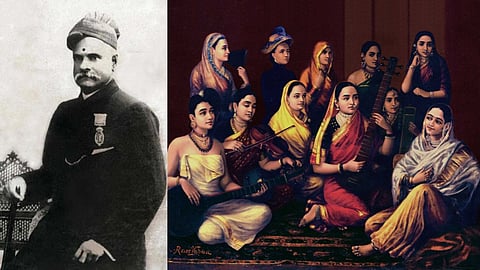
- HOMEGROWN WORLD
- #HGCREATORS
- #HGEXPLORE
- #HGVOICES
- #HGSHOP
- CAREERS
- ABOUT US
- CONTACT US

Modernism in Indian painting emerged in the late 19th and early 20th century, during British colonial rule. Indian artists, inspired by Western art movements, began to experiment with new styles and techniques while also incorporating traditional Indian art forms. The pioneers of Indian modernism, such as Amrita Sher-Gil, Abanindranath Tagore, and Raja Ravi Verma, created a new visual language that reflected the changing social and cultural landscape of India.
Among these celebrated artists, Raja Ravi Verma stands out for his distinctive fusion style that combined Western realism with traditional Indian painting techniques. Born in 1848 in the southern Indian state of Kerala, Verma received training in painting and drawing from his uncle, a well-known artist in the royal court. In the 1870s, Verma began to experiment with oil painting and created a new visual language that was both modern and rooted in Indian culture.
Verma's distinct fusion style was characterized by his use of arresting colors, detailed brushwork, and a focus on capturing the beauty of the human form. He often depicted scenes from Hindu mythology and Indian culture, which were familiar to the Indian audience but presented in a new and refreshing way.
One of Verma's most famous paintings, The Hamsa Damayanti, is a prime example of his fusion style. The painting depicts a scene from Hindu mythology where a swan delivers a message of love from King Nala to his wife Damayanti. The use of bright colors and intricate detailing in the painting makes it stand out, and the European oil painting techniques employed by Verma give the painting a unique and modern look.
Verma's work was also groundbreaking in its representation of Indian women. Unlike many of his contemporaries, he depicted women as strong, independent, and beautiful. This portrayal challenged traditional Indian societal norms and helped to bring about a cultural shift in the perception of women.
Even today, Verma's paintings are still admired for their unique fusion style and their representation of Indian culture and women. He is one of the great masters who artists study and learn from — his use of vivid colors, attention to detail, and the incorporation of traditional Indian art forms into a modern context has greatly enhanced the canvas of Indian modernist art.
The celebrated artist has been on the news lately as Raja Ravi Verma’s last unfinished painting Parsi Lady was recently restored and was unveiled last month on the 29th by Governor Arif Mohammed Khan along with another of his paintings that had not been displayed before, The Portrait of Thriketta Thirunal Uma Amma Thampuratti. The day for the unveiling was chosen to celebrate the occasion of the 175th birth anniversary of the legendary artist.
'Parsi Lady’ had a lot of specialities as it provided a glimpse into the Mumbai life of Ravi Varma and his association with people like filmmaker Dada Saheb Phalke, who was then an employee at the press owned by Ravi Varma. We assume that the painting was a visual adaptation of a Parsi woman he came to know in Mumbai.
Rama Varma Thampuran, General Secretary, Kilimanoor Palace Trust, in an interview with the Hindu
"Whatever he left unfinished is now part of history. We have just restored the painting to its original form by removing the old varnish layers and dirt accumulated on the painting over the years by applying organic chemicals. Further, the original paint layers were consolidated using revivable materials,” said Mr. Madhan. The painting will be unveiled by Governor Arif Mohammed Khan at Kilimanoor Palace on Saturday. However, the paintings will be put up for public viewing a month later as the palace authorities will have to arrange appropriate security measures."
Thampuran, on the rerstoration process of 'Parsi Lady', in an interview with the Hindu
Indian art enthusiasts were overjoyed when they heard the news that the paintings will be open for viewing to the public this month. The paintings are owned by the Kilimanoor Palace Trust and they will be displayed inside ‘Chithrashala,’ the artist’s studio at Kilimanoor Palace, Kerala.
If you enjoyed reading this, here's more from Homegrown:
Modernist Master Jamini Roy's House Will Become India's First Private Artist Museum
The Art Of Devotion: Inside Rajasthan's Rich Tradition Of Picchwai Paintings
A Brief History Of Raagmalas: Ancient Miniature Paintings Inspired By Indian Classical Ragas
